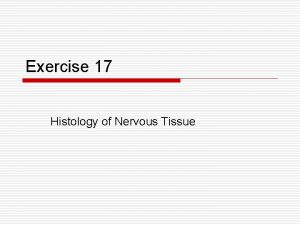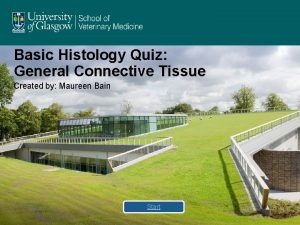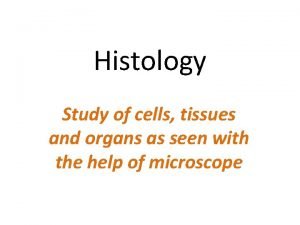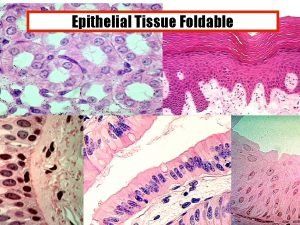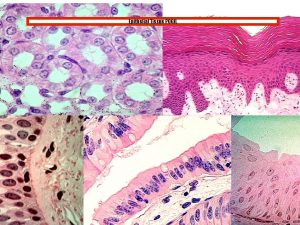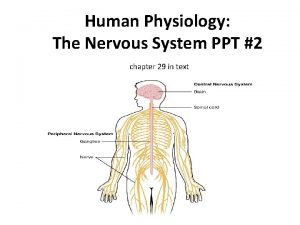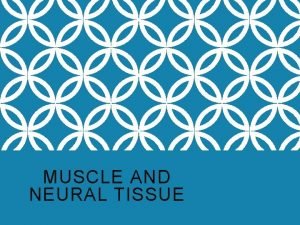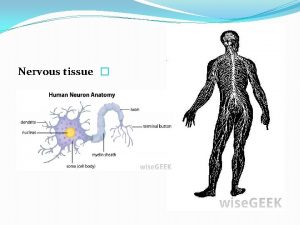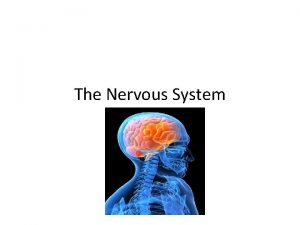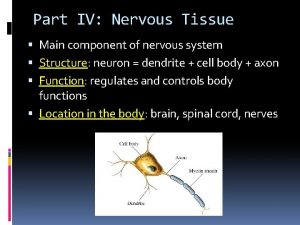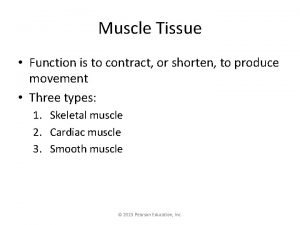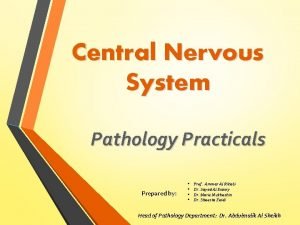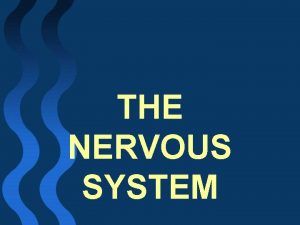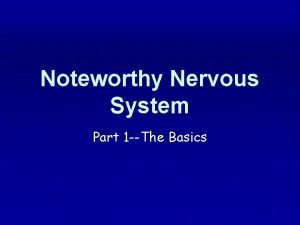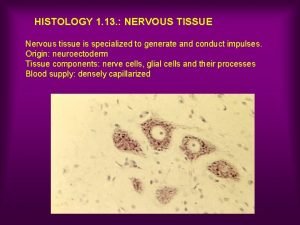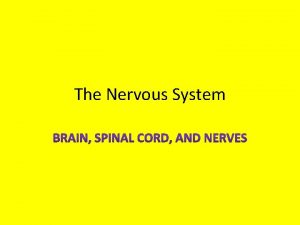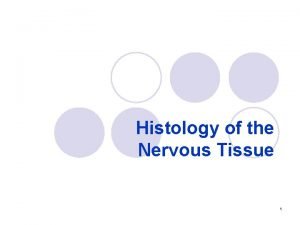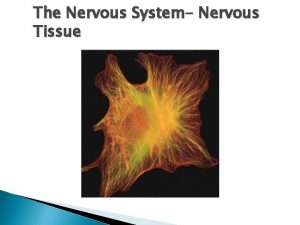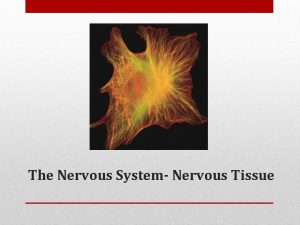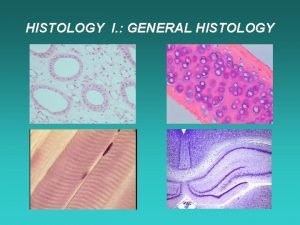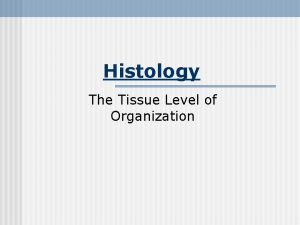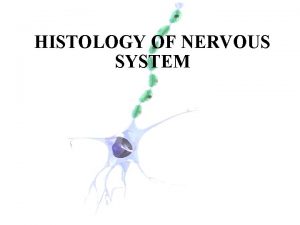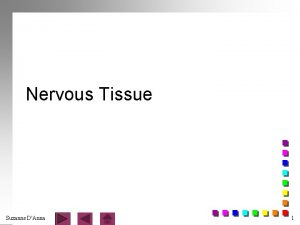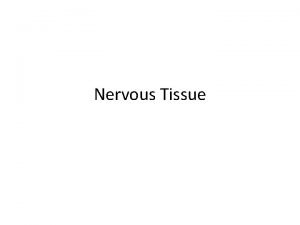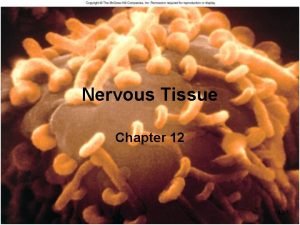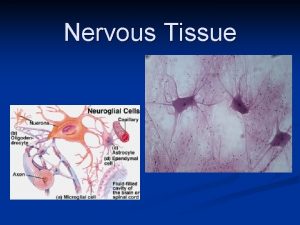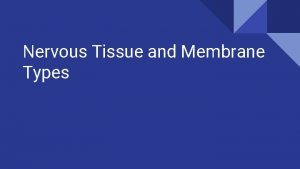Histology of Nervous Tissue Nervous system ppt 2























- Slides: 23

Histology of Nervous Tissue Nervous system ppt #2 Ppt #2

Structure of a Neuron Copyright © The Mc. Graw-Hill Companies, Inc. Permission required for reproduction or display. Dendrites • Neurons are the basic functional units of nervous tissue. • They are highly specialized to transmit nerve impulses. Soma Nucleus Nucleolus Trigger zone: Axon hillock Initial segment • Nervous tissue is made up of just 2 types of cells: Axon collateral Axon • Neurons • Neuroglia (glial cells) Direction of signal transmission Internodes (supporting cells) Node of Ranvier Myelin sheath Schwann cell Terminal arborization Figure 12. 4 a Synaptic knobs (a) 12 -2

Supporting cells of the CNS • Glial cells of the CNS= • • Astrocytes Oligodendrocytes…myelination Microglial Ependymal cells 12 -3

Supporting cells (glial cells) of the PNS • Schwan cells • Satelite cells • These supporting “glial” brace and protect the fragil neuron cells • Act as phagocytes • Control the chemical environment around the nerve cells. • More about supporting cells later 12 -4

All nerve cells have a cell body, also called the soma. This is the control center of the cell . • the cytoplasm contains mitochondria, lysosomes, a Golgi complex, numerous inclusions, and extensive rough endoplasmic reticulum(Nissl bodies) and cytoskeleton • cytoskeleton consists of dense mesh of microtubules and neurofibrils (bundles of actin filaments) 12 -5

Structure of a Neuron Copyright © The Mc. Graw-Hill Companies, Inc. Permission required for reproduction or display. • dendrites – Are RECEPTIVE Dendrites • REGIONS • vast number of branches coming from a few thick branches from the soma – resemble bare branches of a tree in winter – primary site for receiving signals from other neurons – the more dendrites the neuron has, the more information it can receive and incorporate into decision making Soma Nucleus Nucleolus Trigger zone: Axon hillock Initial segment Axon collateral Axon Direction of signal transmission Internodes Node of Ranvier – provide precise pathway for the reception and processing of neural information Myelin sheath Schwann cell Terminal arborization Figure 12. 4 a Synaptic knobs (a) 12 -6

Structure of a Neuron Copyright © The Mc. Graw-Hill Companies, Inc. Permission required for reproduction or display. • axon (nerve fiber) Dendrites cylindrical, relatively unbranched for most of its length Soma Nucleus Nucleolus • Generate and conduct nerve impusles – but branch into co-laterals – Schwann cells and myelin sheath enclose axon – The Axon ends in many small structures called Axon terminals or synaptic knob (terminal button) – little swelling that forms a junction (synapse) with the next cell • contains synaptic vesicles full of neurotransmitter Trigger zone: Axon hillock Initial segment Axon collateral Axon Direction of signal transmission Internodes Node of Ranvier Myelin sheath Schwann cell Terminal arborization Figure 12. 4 a Synaptic knobs (a) 12 -7

• Axons are covered with a fatty material called myelin. • Axons in the PNS are heavily myelinated. • This is done by the Schwann Cells • These Schwann cells layer around the axions and squeeze their cytoplasm out creating many layers of plasma membrane tissues (proteins/lipids) surrounding the axion. This is the Myelin sheath. • Areas of neuron not covered are called Nodes of Ranvier. • Myelin insulates the nerve fibers and greatly increases the speed of neurotransmission by 12 -8 nerve fibers.

• Each axon terminal (synaptic knob) is seperated from the cell body or dendrites of the next neuron by a tiny gap…synaptic cleft. • Neurotransmitters are released into the synaptic cleft and diffuse across to bind to membrane receptors on the next neuron. . initiating an electrical surrent or synaptic potential. 12 -9

Axonal Transport • many proteins made in soma must be transported to axon and axon terminal – to repair axolemma, serve as gated ion channel proteins, as enzymes or neurotransmitters • axonal transport – two-way passage of proteins, organelles, and other material along an axon – anterograde transport – movement down the axon away from soma – retrograde transport – movement up the axon toward the soma • microtubules guide materials along axon – motor proteins (kinesin and dynein) carry materials “on their backs” while they “crawl” along microtubules • kinesin – motor proteins in anterograde transport towards outside 12 -10 • dynein – motor proteins in retrograde transport towards center

• A day in the life of a motor protein, Kinesin • https: //www. youtube. com/watch? v=t. MKl. PDBRJ 1 E • Work horse of the cell: https: //www. youtube. com/watch? v=gbyc. Qf 1 Tb. M 0 • Inner life of a cell: https: //www. youtube. com/watch? v=w. Jy. Utbn 0 O 5 Y • Astonishing molecular machines • https: //www. youtube. com/watch? v=d. MPXu 6 GF 18 M • Drew Barry 12 -11

Neuroglial Cells • about a trillion (1012) neurons in the nervous system • neuroglia outnumber the neurons by as much as 50 to 1 • neuroglia or glial cells – support and protect the neurons – bind neurons together and form framework for nervous tissue – in fetus, guide migrating neurons to their destination – if mature neuron is not in synaptic contact with another neuron is covered by glial cells • prevents neurons from touching each other • gives precision to conduction pathways 12 -12

Six Types of Neuroglial Cells • four types occur only in CNS – oligodendrocytes • form myelin sheaths in CNS • each arm-like process wraps around a nerve fiber forming an insulating layer that speeds up signal conduction – ependymal cells • lines internal cavities of the brain • cuboidal epithelium with cilia on apical surface • secretes and circulates cerebrospinal fluid (CSF) – clear liquid that bathes the CNS – microglia • small, wandering macrophages formed white blood cell called monocytes • thought to perform a complete checkup on the brain tissue several times a day 12 -13 • wander in search of cellular debris to phagocytize

4 Types of Neuroglial Cells in the CNS 1. astrocytes • most abundant glial cell in CNS • cover entire brain surface and most nonsynaptic regions of the neurons in the gray matter of the CNS • diverse functions – form a supportive framework of nervous tissue – have extensions (perivascular feet) that contact blood capillaries that stimulate them to form a tight seal called the blood-brain barrier – convert blood glucose to lactate and supply this to the neurons for nourishment – nerve growth factors secreted by astrocytes promote neuron growth and synapse formation – communicate electrically with neurons and may influence synaptic signaling – regulate chemical composition of tissue fluid by absorbing excess neurotransmitters and ions – astrocytosis or sclerosis – when neuron is damaged, astrocytes form hardened scar tissue and fill space formerly occupied by the neuron 12 -14

12 -15

2 Types of Neuroglial Cells in the PNS – Schwann cells • envelope nerve fibers in PNS • wind repeatedly around a nerve fiber • produces a myelin sheath similar to the ones produced by oligodendrocytes in CNS • assist in the regeneration of damaged fibers – satellite cells • surround the neurosomas in ganglia of the PNS • provide electrical insulation around the soma • regulate the chemical environment of the neurons 12 -16

Neuroglial Cells of CNS Copyright © The Mc. Graw-Hill Companies, Inc. Permission required for reproduction or display. Capillary Neurons Astrocyte Oligodendrocyte Perivascular feet Myelinated axon Ependymal cell Myelin (cut) Cerebrospinal fluid Microglia Figure 12. 6 12 -17

Glial Cells and Brain Tumors • tumors - masses of rapidly dividing cells – mature neurons have little or no capacity for mitosis and seldom form tumors • brain tumors arise from: – meninges (protective membranes of CNS) – by metastasis from non-neuronal tumors in other organs – most come from glial cells that are mitotically active throughout life • gliomas grow rapidly and are highly malignant – blood-brain barrier decreases effectiveness of chemotherapy – treatment consists of radiation or surgery 12 -18

More facts about Myelin • myelin sheath – an insulating layer around a nerve fiber – formed by oligodendrocytes in CNS and Schwann cells in PNS – consists of the plasma membrane of glial cells • 20% protein and 80 % lipid • myelination – production of the myelin sheath – – begins the 14 th week of fetal development proceeds rapidly during infancy completed in late adolescence dietary fat is important to nervous system development 12 -19

Myelin • in PNS, Schwann cell spirals repeatedly around a single nerve fiber – lays down as many as a hundred layers of its own membrane – no cytoplasm between the membranes – neurilemma – thick outermost coil of myelin sheath • contains nucleus and most of its cytoplasm • external to neurilemma is basal lamina and a thin layer of fibrous connective tissue – endoneurium • in CNS – oligodendrocytes reaches out to myelinate several nerve fibers in its immediate vicinity – anchored to multiple nerve fibers – cannot migrate around any one of them like Schwann cells – must push newer layers of myelin under the older ones • so myelination spirals inward toward nerve fiber – nerve fibers in CNS have no neurilemma or endoneurium 12 -20

Myelin • many Schwann cells or oligodendrocytes are needed to cover one nerve fiber • myelin sheath is segmented – nodes of Ranvier – gap between segments – internodes – myelin covered segments from one gap to the next – initial segment – short section of nerve fiber between the axon hillock and the first glial cell – trigger zone – the axon hillock and the initial segment • play an important role in initiating a nerve signal 12 -21

Myelin Sheath in PNS Copyright © The Mc. Graw-Hill Companies, Inc. Permission required for reproduction or display. Axoplasm Axolemma Schwann cell nucleus Neurilemma Figure 12. 4 c (c) Myelin sheath nodes of Ranvier and internodes 12 -22

Diseases of Myelin Sheath • degenerative disorders of the myelin sheath – multiple sclerosis • oligodendrocytes and myelin sheaths in the CNS deteriorate • myelin replaced by hardened scar tissue • nerve conduction disrupted (double vision, tremors, numbness, speech defects) • onset between 20 and 40 and fatal from 25 to 30 years after diagnosis • cause may be autoimmune triggered by virus – Tay-Sachs disease - a hereditary disorder of infants of Eastern European Jewish ancestry • abnormal accumulation of glycolipid called GM 2 in the myelin sheath – – normally decomposed by lysosomal enzyme missing in individuals homozygous for Tay-Sachs allele accumulation of ganglioside (GM 2) disrupts conduction of nerve signals blindness, loss of coordination, and dementia • fatal before age 4 12 -23
 Nervous tissue histology ppt
Nervous tissue histology ppt Which neuron is rare
Which neuron is rare Fundamentals of the nervous system and nervous tissue
Fundamentals of the nervous system and nervous tissue Neuronal processes
Neuronal processes Exercise 15 histology of nervous tissue
Exercise 15 histology of nervous tissue Connective tissue histology quiz
Connective tissue histology quiz Stratified squamous characteristics
Stratified squamous characteristics Pogil definition
Pogil definition Epithelial tissue pogil
Epithelial tissue pogil Paper mold histopathology
Paper mold histopathology Thyroid and parathyroid glands histology
Thyroid and parathyroid glands histology Malt anatomy
Malt anatomy Brain layer
Brain layer What are the characteristics of nervous tissue
What are the characteristics of nervous tissue Classify nervous tissue
Classify nervous tissue Nervous tissue in the lungs
Nervous tissue in the lungs Nervous tissue repair
Nervous tissue repair Nerve tissue description
Nerve tissue description Type of muscle
Type of muscle Glioblastoma multiforme
Glioblastoma multiforme Nervous tissue
Nervous tissue Diagram of nervous tissue
Diagram of nervous tissue Nervous tissue
Nervous tissue Building vocabulary activity: the central nervous system
Building vocabulary activity: the central nervous system




